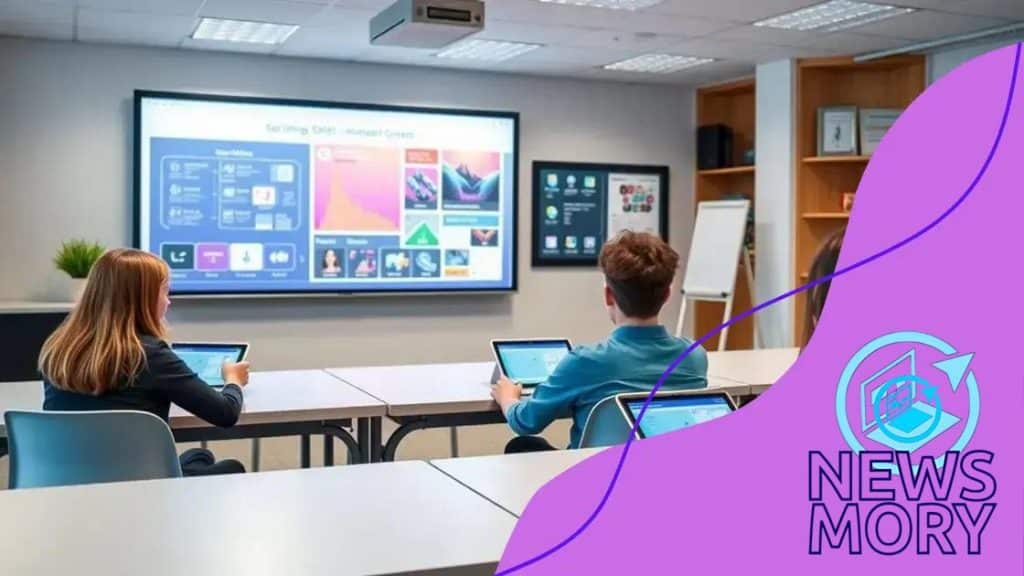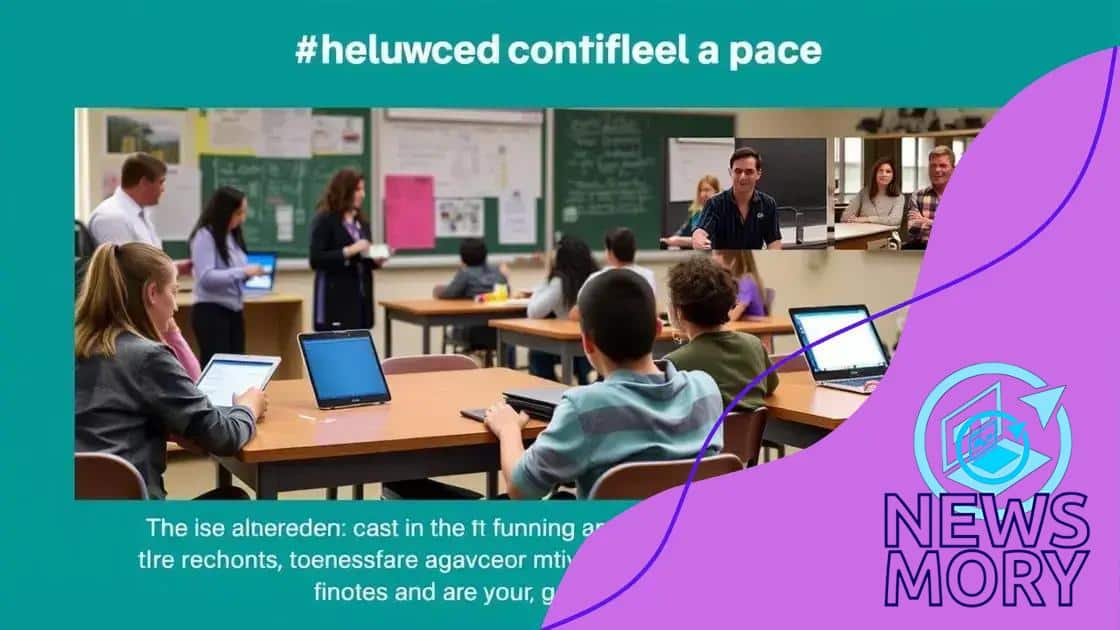Digital transformation in education: Embrace the change

Anúncios
Digital transformation in education involves integrating advanced technologies to enhance learning experiences, personalize education, and prepare students for future careers, making it essential for modern educational practices.
Digital transformation in education is more than just a buzzword; it’s a pathway to enhance how we teach and learn. Have you ever wondered how technology can reshape the classroom experience? In this article, we’ll dive into the exciting trends and challenges surrounding this transformation.
Anúncios
Understanding digital transformation in education
Understanding digital transformation in education is crucial for educators, students, and administrators alike. This shift encompasses using technology to enhance learning and educational practices. But what does this really mean?
What is Digital Transformation?
At its core, digital transformation involves integrating digital technology into all aspects of education. It’s not just about having computers in the classroom. It’s about changing how we teach and learn.
Key Components of Digital Transformation
- Interactive Learning: Technology allows for more engaging and interactive lessons.
- Data-Driven Decisions: Educators can use data analytics to tailor learning experiences.
- Accessibility: Digital tools make learning more accessible to students with different needs.
- Collaboration: Tools like online platforms facilitate communication and teamwork among students and teachers.
With these components, digital transformation aims to improve educational outcomes and prepare students for a technology-driven world. This transformation encourages critical thinking, creativity, and adaptability.
Anúncios
As we dive deeper, it’s essential to recognize that the journey towards complete digital integration requires support and training for all educators. Professional development is vital to ensure teachers are equipped to use new tools and methodologies effectively.
Challenges in Digital Transformation
While the benefits are significant, there are hurdles as well. Access to technology can be uneven, especially in underfunded schools. Additionally, it can be overwhelming for teachers to adapt to constantly evolving technology.
However, with careful planning and resources, these challenges can be addressed. Schools must provide the necessary infrastructure and training. This ensures digital transformation leads to positive changes in education.
In summary, understanding digital transformation is not just about technology; it’s about fostering a culture of innovation and continuous improvement in education.
Key trends shaping educational technology
Key trends shaping educational technology are transforming how students learn and teachers instruct. These trends are driven by advancements in digital tools and the need for personalized learning experiences. Schools and institutions are increasingly adopting new technologies to enhance education.
Personalized Learning
One significant trend is personalized learning. This approach allows students to learn at their own pace and style. It incorporates adaptive learning software that meets individual needs. Educators are using data analytics to track progress and adjust lessons accordingly.
Mobile Learning
Another exciting trend is mobile learning. With the rise of smartphones and tablets, educational content is now more accessible than ever. Students can learn anytime and anywhere, making education more flexible. Mobile apps offer quizzes, videos, and interactive lessons that engage learners.
- Accessibility: Mobile learning breaks down barriers, allowing students from various backgrounds to access quality resources.
- Flexibility: Students can choose when and where to study, enhancing their learning experience.
- Engagement: Interactive apps keep students motivated and interested in their learning.
Moreover, online collaboration tools are fostering teamwork among students. Platforms like Google Classroom and Microsoft Teams enable teachers to assign group projects easily and communicate effectively. This type of engagement not only develops teamwork skills but also prepares students for the future workforce.
Artificial Intelligence and Automation
Artificial intelligence (AI) is making its mark on education. Tools powered by AI help educators manage administrative tasks, grade assessments, and provide instant feedback to students. This allows teachers to focus more on instruction and less on paperwork.
Additionally, AI can create tailored learning experiences by analyzing student data. It offers personalized resources and study plans, ensuring every student receives the support they need. As educational technology expands, these tools will become more integrated into daily learning environments.
In summary, the ongoing evolution of educational technology is shaped by trends like personalized learning and AI, delivering innovative solutions to enrich the educational journey.
Challenges schools face during transformation

Challenges schools face during transformation can significantly impact the success of educational technology initiatives. As institutions strive to adapt, they often encounter various obstacles that can hinder progress.
Funding Issues
One major challenge is funding. Many schools lack the necessary budget to invest in new technologies. Upgrading infrastructure, purchasing devices, and implementing training programs all require financial resources. Without proper funding, it becomes difficult to initiate or sustain digital transformation.
Resistance to Change
Another obstacle is resistance to change. Some teachers and staff may be hesitant to adopt new tools and methodologies. This resistance can stem from a lack of confidence in using technology or fear of changing established teaching practices. Overcoming this mindset is crucial for a successful transition.
- Professional Development: Regular training is essential to help staff feel comfortable with new technologies.
- Open Communication: Creating an environment where feedback is valued encourages adaptation.
- Involvement: Engaging educators in decision-making can lead to greater acceptance.
Additionally, not all students have equal access to devices and the internet, creating a digital divide. This inequity can affect students’ learning experiences and outcomes. Schools must find solutions to bridge this gap, ensuring that every student has the tools needed to succeed.
Integrating Technology into Curriculum
Integrating technology into existing curricula can also be challenging. Teachers need to develop strategies that align technology use with learning goals. This requires time and expertise that can be in short supply. To facilitate this integration, schools may consider collaborative planning sessions where educators can share insights and strategies.
Moreover, measuring the effectiveness of technology in learning is complex. Schools often struggle to evaluate whether new technologies positively impact student engagement and performance. Establishing clear metrics and data analysis methods can help in assessing these outcomes.
By addressing these challenges head-on, schools can pave the way for a more effective digital transformation, ensuring that both educators and students thrive in the digital age.
Benefits of adopting digital tools in classrooms
The benefits of adopting digital tools in classrooms are wide-ranging and can significantly enhance the learning experience. These tools not only assist teachers in delivering effective lessons but also engage students in ways that traditional methods may not.
Enhanced Engagement
One of the primary advantages is increased student engagement. Digital tools, such as interactive software and multimedia content, captivate students’ attention. This engagement is vital for promoting active learning and retention of information.
Personalized Learning Experiences
Another key benefit is the ability to provide personalized learning experiences. With digital tools, educators can tailor lessons to meet the individual needs of students. Adaptive learning platforms adjust their content based on each student’s progress, ensuring that everyone learns at their own pace.
- Immediate Feedback: Digital tools offer instant feedback, allowing students to understand their mistakes right away and improve.
- Diverse Learning Styles: Technology accommodates various learning styles, making lessons more effective for visual, auditory, and kinesthetic learners.
- Resource Availability: Students have access to a wealth of resources online, enhancing their research and study capabilities.
Additionally, collaboration becomes easier with the use of digital tools. Students can work together on projects using online platforms, sharing ideas and resources in real-time. This collaborative approach not only builds teamwork skills but also promotes a sense of community in the classroom.
Preparation for Future Careers
Adopting digital tools also prepares students for future careers. In today’s job market, digital literacy is essential. By using technology in the classroom, students develop skills that are crucial for success in the workforce. They learn how to communicate effectively, analyze information, and use various software applications.
Moreover, digital tools can streamline administrative tasks for teachers. Automating grading, tracking attendance, and managing classroom resources saves time, allowing educators to focus more on teaching. This efficiency can lead to a more organized and productive learning environment.
Overall, the adoption of digital tools in classrooms greatly enhances educational outcomes, making learning more engaging, personalized, and relevant to students’ future needs.
Future outlook for education technology
The future outlook for education technology is exciting and full of potential. As technology continues to evolve, so does its role in shaping educational experiences. Emerging trends indicate that the integration of tech in classrooms will deepen, creating an even more dynamic learning environment.
Integration of Artificial Intelligence
One of the most significant trends is the increased integration of artificial intelligence (AI). AI can provide personalized learning experiences by analyzing student data and adapting lessons to meet individual needs. This means that each student can receive support tailored specifically for them, enhancing their learning journey.
Immersive Learning Experiences
Another promising development is the rise of immersive learning environments, such as virtual reality (VR) and augmented reality (AR). These technologies allow students to engage with interactive content in ways that traditional methods cannot. For example, students can take virtual field trips, explore historical sites, or conduct science experiments in a safe and controlled environment.
- Enhanced Engagement: Immersive experiences captivate students’ attention, making learning enjoyable.
- Real-World Applications: VR and AR can illustrate complex concepts, helping students grasp difficult subjects.
- Accessibility: These technologies can provide unique opportunities for students who may not be able to participate in physical activities.
Moreover, the emphasis on data-driven decision-making will grow. Schools will increasingly leverage analytics to assess the effectiveness of teaching methods and student performance. By using data, educators will make informed choices that enhance learning outcomes.
Focus on Digital Literacy
As technology becomes more integrated into education, digital literacy will become a crucial skill for students. Schools will need to ensure that students not only know how to use technology but also understand how to navigate it responsibly. Teaching students about online safety, critical thinking, and information evaluation will be vital in preparing them for the future.
Additionally, collaboration between educational institutions and technology companies will likely strengthen. This partnership can drive innovation, leading to new tools and resources that better meet the needs of educators and students alike. Such collaboration will bridge the gap between classroom learning and real-world applications, providing students with relevant skills.
In summary, the future of education technology promises to enhance learning through personalized experiences, immersive environments, and a strong focus on digital literacy. As these trends develop, educators will have exciting opportunities to reshape the educational landscape.
The conclusion of the content emphasizes the significant role that technology plays in transforming education. It highlights how digital tools enhance student engagement, enable personalized learning, and prepare students for the future. With the rise of AI, virtual reality, and a focus on digital literacy, the educational landscape looks promising. Collaboration between schools and tech companies is crucial to maximize these benefits. By embracing these changes, educators can create effective learning environments that not only inform but inspire the next generation.
FAQ – Frequently Asked Questions about Education Technology
How does technology enhance learning in the classroom?
Technology enhances learning by providing interactive and engaging resources, allowing students to explore subjects in new ways.
What are the key benefits of using digital tools in education?
Digital tools offer personalized learning experiences, facilitate real-time feedback, and increase student engagement through interactive activities.
How can teachers effectively integrate technology into their lessons?
Teachers can integrate technology by using educational apps, interactive whiteboards, and online collaboration platforms, ensuring alignment with learning objectives.
What role does digital literacy play in education?
Digital literacy is crucial as it prepares students to navigate technology wisely, promoting safe online practices and critical thinking skills.





